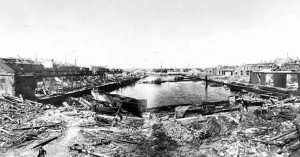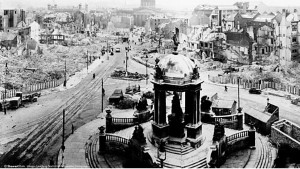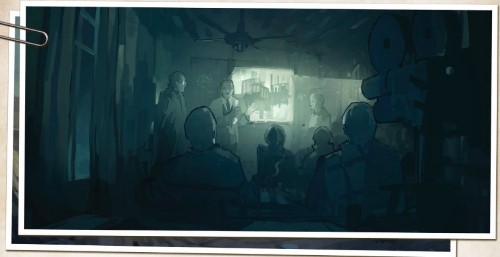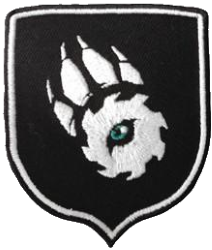
Tracks of Time |
 |
Two days later, the party disembarked from El Conpino, and found themselves in a desolate, ruined land. Liverpool... The Blitz was still at its' height here, and the Luftwaffe had done some real damage. Part of the docks was pretty much levelled after the explosion of the ammunition ship Malakand, and the resulting fire had just been put out.
 |
As the part stepped ashore, a harbour worker was waiting with a telegram, which he handed to Anné who happened to be first off. Ripping it open, she read as follows:
GO TO LIME STREET STATION STOP ASK AT THE TICKET OFFICE FOR A RESERVATION UNDER THE NAME JANE NOE STOP YOUR TRAVEL WARRANTS WILL BE THERE REGARDS ALEC END
Sure enough, the tickets were there, and the group embarked for the south.
Nearly a day's travelling over railways varying between normal and barely lashed together across hastily-filled bomb craters, the team reached Hayes station, the nearest to Clemens Park. Waiting for them was a familiar figure, the broken-nosed, chunky chauffeur and handyman Arthur Morris. He knew most of them from their first mission, and smiled his battered smile as he loaded them aboard to drive them to the Park.
Once the team had been debriefed and turned in their reports, sketches, samples and so on, a couple of weeks elapsed as the experts at Clemens and elsewhere analysed the information and collated it with other Intelligence sources with relevant facts.
 |
During that time, the team had rested and recuperated, and busied themselves with various tasks. Cyril had been up town, and replaced his stock of cigars, brandy and lighter fluid - all hard to find, especially as his usual tobacconist was now a heap of bricks, rubble and ash. Joe had reported back to the tank training facility on Salisbury Plain, and spent time there both training new crews and learning more about the new Cavalier tanks, an early version of what was to become the Cromwell.
Anné, Marcus and Charlie had visited the weapons labs, where the engineers had expressed admiration for the field repairs to the Arclite rifle, and had trained Anné in more detail on how to maintain it. Hers was now completely working and ready for use. She was a little taken aback to discover that she was the first actual survivor of a serious Arclite malfunction.
 |
Marcus asked if they could be equipped with flamethrowers, which drew a bit of a wince. Their faces cleared a bit, however, as one of them lifted a weapon from a bench and hefted it carefully. "This," he said, "is a Blevins Steam-Assisted Enzymatic Carbine. Developed from the samples you retrieved, actually, which allowed us to discover that certain enzymes dissolve the physical makeup of some trans-dimensional creatures. It fires a gout of superheated steam and high-temperature-activated enzymes, dissolving large chunks of monstrous flesh almost instantly." He connected a thick cable between the weapon and a pack around the size of a standard gas-mask case. "The range is short," he said apologetically, but it should mess up monsters quite nicely. We've issued the smaller, pistol version to 'Badger' Harris, but if you'd like to field-test these, please do. We have two." He rubbed his chin. "Just don't try taking the pack apart. Bad things might happen."
Many of the team spent time learning spells they'd happened across, with Marcus and Joe learning the Gate enchantment. Marcus was a little worried about how much the spell might take out of him; his use of magic was having effects on him. Needs must, however - there was a war on!
 |
Finally, Alec called a briefing session, and the team took their places in the usual room.
His first action, typically of the man, was to thank the team for their efforts in Peru, despite the lack of a successful outcome. He noted that their notes, photographs, samples and reports had been of great use. He then moves on to some intelligence reports that seem of great relevance.
 |
A Danish resistance agent had managed to get a report to an old friend in British Intelligence, describing the departure of a ship loaded with crates of equipment and outfitted for the Arctic, headed for Greenland. A "robust-looking dark-haired German woman" appeared to be in command, accompanied by a Tibetan monk in a blue robe. Troops were seen boarding, all with a peculiar wolf's-paw badge on their uniforms. Nachtwölfe; and the Monks of the Veiled Monastary.
The books in question seem to have been part of a gift sent by the Bishop of Skálholt, Iceland, to the King of Denmark in the mid-17th Century. One, the Codex Regius (the Royal Book), is a work of old Norse poetry also known as the Poetic Edda. The other, also somewhat confusingly referred to as the Codex Regius and part of the same bequest as the Poetic Edda, is usually identified as the Prose (or Snorri’s) Edda. The Eddas are two important collections of Old Norse texts. The first and oldest, the Poetic Edda, is considered to be lost until 1643 when it is discovered by the Bishop of Skálholt. Its existence had been surmised from references to it in the Prose Edda, written or compiled by the Icelandic politician and author, Snorri Sturluson, in the 13th Century as an instructional manual for poets. Written in alliterative verse, the Poetic Edda contains stories of the creation, destruction, and rebirth of the Norse mythical world, as well as tales of Norse and Germanic heroes and heroines (many of which go on to form the basis of the Nibelungenlied, which in turn forms the core of Richard Wagner’s Ring Cycle of operas). No-one knows who wrote the poems or how old they actually are, although several are believed to have come from Greenland. What is known is that they form one of the most complete sources of Norse mythology in existence. One book within the Poetic Edda, the Hávamál (Sayings of the High One), describes how Odin acquired the power of the runes, as well as containing a useful list of magical charms. The Prose Edda consists of four parts, the first of which contains Christianised versions of the Norse myths. According to Sturluson, the Norse gods were not deities to begin with, but escapees from the city of Troy who found their way North. Hailed as divine beings for their advanced technological skills by the local population, it was only after the Trojans’ deaths that they ascended to full godhood, when devotional cults grew up around their burial mounds. As with the origins and authors of the stories the two books contain, no-one is entirely certain where they get their name from. “Edda” may mean “knowledge” via Latin and Icelandic wordplay, but by the Middle Ages it was taken to stand for “Poetic Art”. Regardless, the Poetic Edda is translated into English in 1936 by Henry Adam Bellows, and there are those who believe both it and the Prose Edda contain far more than a collection of interesting fables and a primer of how to understand Icelandic skaldic poetry. Rudolf Gorsleben believes that the Eddas are the best source of Aryan history in existence, and sets up the Edda Society, an Aryan study group, in November, 1925. Gorsleben, a firm believer in reincarnation and the power of runes, also holds that all life began at the North Pole but was forced south to Atlantis as the polar regions cooled. An earlier ariosophist, Guido von List, also postulates a northern origin for Aryan civilisation. In his opinion, the poems of the Eddas are much older than the historians give them credit for. He regards them as a sacred text written before the onset of the last Ice Age, and most certainly not from the hands of Icelandic and Scandinavian minstrels and poets. |
The agent did some following up, and discovered that the monk and the woman had been frequent visitors to the Ancient section of the Royal Library in Copenhagen. where they had been researching into the Norse Eddas.
A seperate contact in Greenland has reported the ship arriving, sitting in Scoresbysund for some time, being joined by a group matching the rough description of the Nachtwölfeteam from Peru, then heading off south. This contact would be available to assist them on arrival.
Next, the scientist Dr Dennis Parker stood up. He, too, was familiar from the early days of the team, and nodded to those he recognized.
"We've spent some considerable time analysing the information to hand, and working on the pieces of the Palladion we have," he said. Two of them, the Agneya Weapon of Flame you found in India and the Clypeus you, er, robbed a train in Italy for, are non-functional, one sabotaged in antiquity and the other probably damaged by Shoggoth acid."
"The Mitawai, as you know, we havent't got."
"We've had more success with the Cup of Yima and the Aten Life Giver," he said, brightening up and gesturing to where the green glass Rhyton from Persia was connected to the 3' golden sun disk from Egypt. "Frankly, we don't know what powers it," he said with a shrug, "but with these two connected, a viewer can see things up to ten miles away."
Parker paused, as if waiting for something, then sat down with an air of mild disappointment.
 |
Alec gestured to his other side, where a diminutive redheaded woman sat. "This is Signy Olvisdottir, Professor of Nordic Languages at Edinburgh University." he explained. She stood up.
"I've translated the runes on the - excellent - photographs and sketches you brought back. The results were sent to your Professor Deadman" there's just a pause there, and it seemed she might have a slight interest in the pale American academic, "and he returned his results. I'm told it's a 'spell' and specifically that anyone mastering it will be able to tell where the 'Gate' you found in Peru connected to." Her intonation suggested - especially to Joe - that she also was very much a sceptic where the Art Magic was concerned. She smiled, and sat down.
 |
Alec then adjourned the meeting and led the way down into the cavernous, fortified cellars under Clemens Park, and down a corridor none of them had seen before. At the end was a large, bare room sealed with concrete, at the far end of which was a big slab of stone. Into this had been carved concentric circles of Norse runes, identical to those on the wall of the temple in Peru.
All that remained was to plan their expedition through the Gate, and collect necessary equipment. There was some talk of horses, but in the end the idea of motorcycles won out, and the team got some spot training on how to ride one.
Session Date: 25th March 2020 - in CyberSpace! |